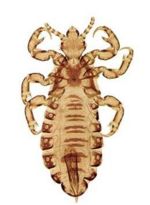Difference between revisions of "Louse Structure"
| (2 intermediate revisions by the same user not shown) | |||
| Line 1: | Line 1: | ||
| − | |||
| − | |||
| − | |||
Lice are obligate ectoparasites of every avian and most mammalian species. They are only a few millimeters long and like [[Fleas|fleas]], are wingless but unlike fleas are dorsoventrally flattened. | Lice are obligate ectoparasites of every avian and most mammalian species. They are only a few millimeters long and like [[Fleas|fleas]], are wingless but unlike fleas are dorsoventrally flattened. | ||
| Line 10: | Line 7: | ||
There are two main groups of veterinary importance, the ''Mallophaga'' (chewing lice) and ''Anoplura'' (sucking lice) | There are two main groups of veterinary importance, the ''Mallophaga'' (chewing lice) and ''Anoplura'' (sucking lice) | ||
| − | + | '''[[:Category:Chewing Lice|Chewing Lice (Mallophaga)]]''' | |
| − | + | They are also known as biting lice. They have a broad head, and the thorax narrower than the head. These lice have rasping mouthparts, and feed on epithelial scales, scabs, feathers and other bodily debris. | |
Species occur on both mammals and birds. | Species occur on both mammals and birds. | ||
| − | + | '''[[:Category:Sucking Lice|Sucking Lice (Anoplura)]]''' | |
| + | |||
| + | [[Image:Sucking Louse.jpg|thumb|right|150px|Sucking Louse ''Pediculosis humanus'' <br> Smith VS et al. 2004, WikiMedia Commons]] | ||
| − | + | They have a narrow head, and the thorax wider than the head. They have powerful legs, and piercing mouthparts, used to feed on blood and tissue fluids. Heavy infestations can cause [[:Category:Anaemia|anaemia]]. | |
Species occur only on mammals. | Species occur only on mammals. | ||
| Line 25: | Line 24: | ||
| + | [[Category:To_Do_-_Parasites]] | ||
[[Category:Lice|A]] | [[Category:Lice|A]] | ||
Revision as of 20:16, 27 March 2011
Lice are obligate ectoparasites of every avian and most mammalian species. They are only a few millimeters long and like fleas, are wingless but unlike fleas are dorsoventrally flattened.
Lice are host specific, permanent parasites which cause pediculosis. The louse saliva and faeces contain allergenic substances which cause irritation, rubbing, licking and skin damage leading to decreased host productivity.
Mammalian lice species have a single pair of claws on the ends of stout legs, whereas avian lice species have a double claw on each leg.
There are two main groups of veterinary importance, the Mallophaga (chewing lice) and Anoplura (sucking lice)
They are also known as biting lice. They have a broad head, and the thorax narrower than the head. These lice have rasping mouthparts, and feed on epithelial scales, scabs, feathers and other bodily debris.
Species occur on both mammals and birds.
They have a narrow head, and the thorax wider than the head. They have powerful legs, and piercing mouthparts, used to feed on blood and tissue fluids. Heavy infestations can cause anaemia.
Species occur only on mammals.
